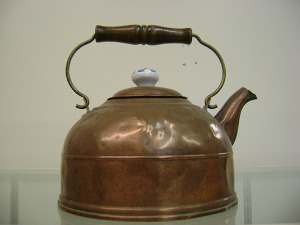 very member of a family was expected to contribute to its welfare. Although women did some outside chores, their primary tasks were child rearing, cooking, and providing clothes for the family. To accomplish this women spent hours quilting, knitting and sewing clothes. The home display includes items from the early 1900s through the 1950s.
very member of a family was expected to contribute to its welfare. Although women did some outside chores, their primary tasks were child rearing, cooking, and providing clothes for the family. To accomplish this women spent hours quilting, knitting and sewing clothes. The home display includes items from the early 1900s through the 1950s.
The Wedgewood stove was manufactured in Newark; one of two stove factories in the area, the other being the Occidental Stove Company in Irvington.
The mangle was used by many women to keep up with the constant ironing of shirts, sheets, and underwear, etc.
The foot-operated sewing machine is from the early 1900s.
The hand-made pillowcase (donated by Rosemary Ramsell) and the embroidered towels are examples of handiwork by housewives.
Varieties of grinders are exhibited (used to grind coffee, nuts, bread crumbs, cheese).
Across from the kitchen is the Washing Day display. Here is an electric washing machine from about 1953. It came from the Joe Silva farm in Warm Springs. To start the process, the basin was filled with a hose from a nearby sink.
Rosemary Ramsell used a wooden ironing board, clothespin carrier with clothespins, and a washing board. Other washday necessities were the Oxidol washing soap and a Coca-Cola bottle with a sprinkler head. It was filled with water and used to sprinkle clothes before ironing them.
The Fireless Range Cooker used electricity and kept soup warm for hours by heating iron plates.
The selection of andirons includes those heated by gas, charcoal and by heat transference on wood stoves.